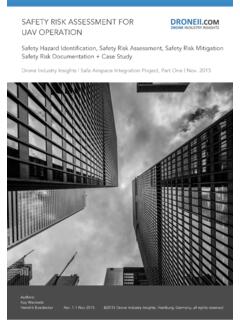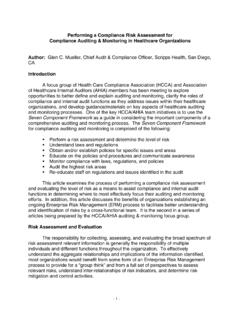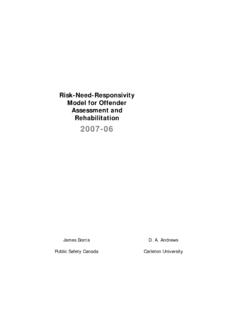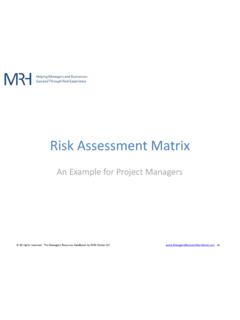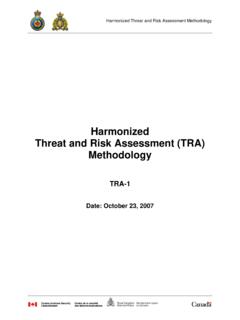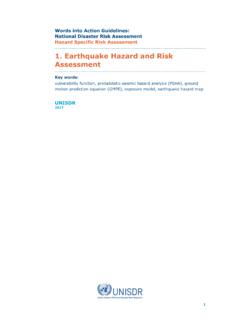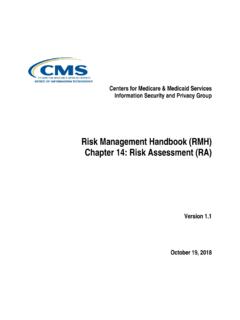Transcription of Enterprise Risk Management Maturity Model - OECD
1 FORUM ON TAX ADMINISTRATIONOECD Tax Administration Maturity Model SeriesEnterprise Risk Management Maturity Model Forum on Tax Administration Enterprise Risk Management Maturity Model PUBE 2 | Enterprise RISK Management Maturity Model OECD 2021 This document, as well as any data and any map included herein, are without prejudice to the status of or sovereignty over any territory, to the delimitation of international frontiers and boundaries and to the name of any territory, city or area. This document was approved by the Committee on Fiscal Affairs on 4 February 2021 and prepared for publication by the OECD Secretariat.
2 Please cite this publication as: OECD (2021), Enterprise Risk Management Maturity Model Maturity Model , OECD Tax Administration Maturity Model Series, OECD, Paris. Photo credits: Suppachok N OCDE 2021 The use of this work, whether digital or print, is governed by the Terms and Conditions to be found at | 3 Enterprise RISK Management Maturity Model OECD 2021 Preface On behalf of the Organisation for Economic Co-operation and Development s Forum on Tax Administration (OECD FTA), I am pleased to present the Enterprise Risk Management (ERM) Maturity Model .
3 The United States Internal Revenue Service (IRS) worked closely with our colleagues in the OECD FTA Enterprise Risk Management Community of Interest (COI) and the Secretariat to develop the Maturity Model set out in this report. This Maturity Model , the latest in the FTA Maturity Model series, is a product of the collective expertise and experience of participating FTA members. I would like to extend my gratitude to everyone involved in developing what I believe is an important new resource which I hope will be of use to all tax administrations at whatever stage of Maturity they are currently. I hope that this report is also timely. We are, of course, currently facing the enormous challenges of the global COVID-19 pandemic, which may have lasting impacts on how we operate.
4 We are also living through a period of increasingly rapid changes resulting from the digitalisation of the economy, the emergence of new technologies and the challenges of climate change among other things. These developments will have significant impacts on many aspects of our lives and work and, consequently, on how we operate as tax administrations. The ability to identify, understand and mitigate risks appropriately is more important than ever. My hope is that this new Maturity Model will help us in understanding our capabilities in this area in an objective and testable manner, to provide staff and senior leadership with an overview of their administration s Maturity level, including in comparison to their peers, and to inform decision-making going forward.
5 I encourage organizations to use this Enterprise Risk Management Maturity Model to help in guiding their risk Management efforts and in managing their journey in fostering their ERM capabilities. Thomas Brandt Chief Risk Officer United States' Internal Revenue Service 4 | Enterprise RISK Management Maturity Model OECD 2021 Table of contents Preface 3 Executive Summary 5 1 Using the Enterprise Risk Management Maturity Model 7 General background 7 Maturity levels 7 Layout of the Maturity Model 8 Using the Maturity Model 9 Recording of self-assessments 10 2 Results of Self-Assessments 11 Self- assessment results 11 Self- assessment process 12 3 The Enterprise Risk Management Maturity Model 14 4 Glossary of Key Terms 23 Reference 25 Annex A.
6 Enterprise Risk Management Maturity Model : Self- assessment record sheet 26 Self- assessment record 26 | 5 Enterprise RISK Management Maturity Model OECD 2021 Executive Summary Maturity models are a relatively common tool, often used on a self- assessment basis, to help organisations understand their current level of capability in a particular functional, strategic or organisational area. In addition, the setting out of different levels and descriptors of Maturity can help an organisation achieve a common understanding of the type of changes that would be likely to enable it to reach a higher level of Maturity over time, should it so wish.
7 The OECD Forum on Tax Administration (FTA) first developed a Maturity Model in 2016 in order to assess digital Maturity in the two areas of natural systems/portals and big data. The digital Maturity Model was introduced in the OECD report Technologies for Better Tax Administration (OECD, 2016[1]). Building on this, work began in 2018 to develop a set of stand-alone Maturity models over time covering both functional areas of tax administration, such as auditing and human resource Management , as well as more specialised areas such as Enterprise risk Management , analytics and the measurement and minimisation of compliance burdens.
8 The Maturity Model contained in this report covers the organisational and operational aspects of Enterprise risk Management . The aim of the Enterprise Risk Management Maturity Model is to: Allow tax administrations to self-assess through internal discussions as to how they see their currently level of Maturity in Enterprise risk Management . There is not a prescribed optimal level of Maturity for tax administrations. The level of Maturity will depend on each organisation s circumstances, broader objectives, and priorities. Provide staff and senior leadership of the tax administration with a good overview of the level of Maturity based on input from stakeholders across the organisation.
9 This can help in deciding strategy and identifying areas for further improvement, including areas that require support from other parts of the tax administration or external stakeholders, including other parts of government. A number of administrations have reported that cross-organisational conversations when self-assessing can be useful in joining-up different business areas, helping people see the scope for synergies and identify areas for mutual support. Allow tax administrations to compare where they sit compared to their peers. A heat map contained in this report shows the reported Maturity of the different administrations that have so far conducted a self- assessment .
10 This is set out on an anonymous basis. An administration will know its own level and will be able to compare itself to other tax administrations. It is also possible for tax administrations to reach out, through the Secretariat, to other tax administrations at different levels of Maturity for peer-to-peer learning purposes. This report consists of five parts: Chapter 1: Using the Enterprise Risk Management Maturity Model . This provides an overview of the Model and an explanation of how to use the Model , including how to get the most out of discussions within the tax administration. Chapter 2: Results of self-assessments.










